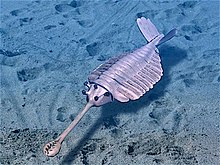
|




The Cambrian explosion is when many animal phyla first appeared in the fossil record. It happened 541 million years ago (mya). Probably most had evolved before then, but that was their first appearance as fossils.
Before about 580 mya it seems that most organisms were simple. They were made of individual cells, occasionally organized into colonies. Over the following 70 or 80 million years the rate of evolution seemed to accelerate. By the end of the Cambrian most phyla we know today existed.